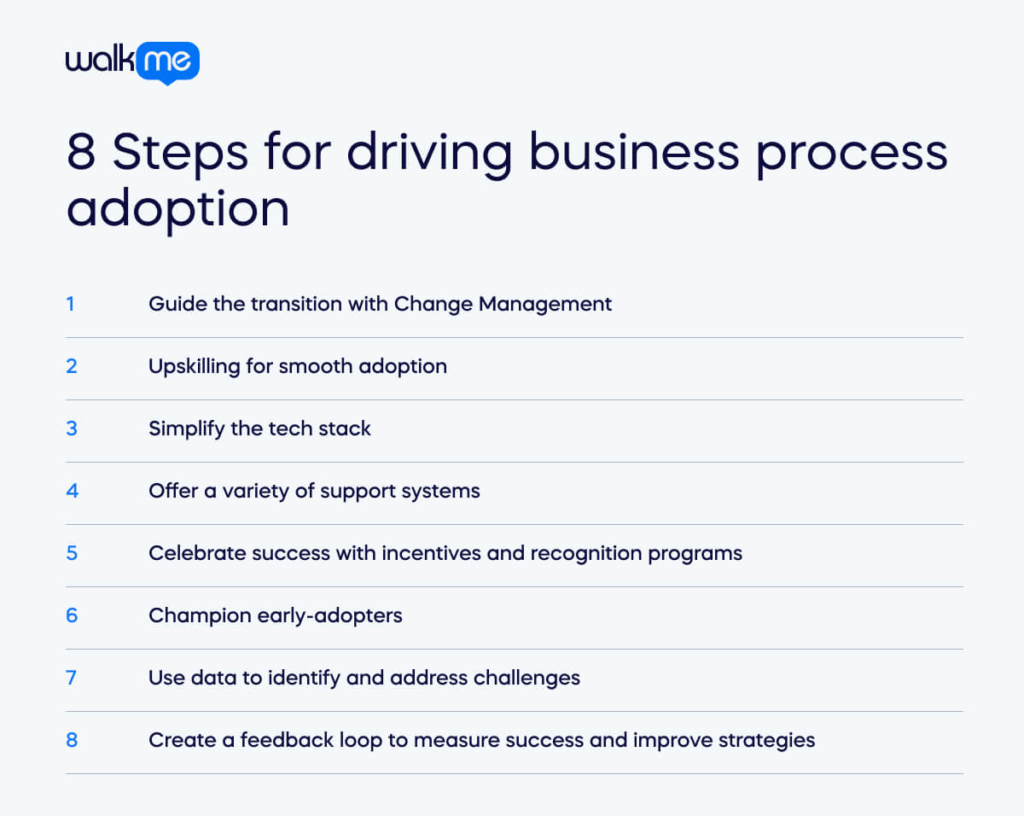Organizational effectiveness depends on how well a company is able to transform. This is what separates companies that thrive on innovation from those stuck in rigid cultures, unable to adapt.
Transformations among today’s future-ready firms may involve introducing new workflows, automating processes, or increasing IT investments that reimagine core operations.

A recent study by Camunda found that nearly all businesses (97%) agree that automation is essential for successful digital transformation. This is what we call business process adoption (BPA)—or, in simpler terms, how well an organization introduces new or changed ways of working into practice.
Streamlined BPA efforts are a key characteristic of an agile organization, helping employees to fine-tune their approach while staying aligned with strategic goals.
This article explores how to drive business process adoption in eight simple steps, discussing the benefits, challenges, and why it’s important.
What is business process adoption?
Business process adoption is about successfully bringing changes into a company. These typically involve new or modified ways of doing things, such as changes to people, workflows, technologies, and even the core functions of the business.
Business process management (BPM) is the bigger picture that makes successful business process adoption possible. BPM focuses on the nuts and bolts of designing, implementing, and managing an organization’s core workflows, while process adoption puts those improvements into action.
This is achieved when all members of an organization can transition to new ways of working while keeping productivity high and disruptions to a minimum. It represents how employees overcome learning curves and resistance to change and have the know-how to effectively embrace and execute new processes.
8 Steps for driving business process adoption

At its core, adopting any new process will require change.
While there may be no shift in the overall goals or desired outcomes, adopting the agile process certainly shakes things up regarding how we work to achieve those goals.
Just like changing the processes themselves, organizational leaders need to make equally impactful adjustments to ensure their workforce is onboard and can keep pace with the speed of innovation.
Below, we’ll explore eight steps to ease process adoption and ensure every employee has the support they need to progress.
1. Guide the transition with Change Management
Change can be disruptive. Gartner research shows that employees faced up to 10 work changes annually, and willingness to support new changes dropped from 74% to just 43% between 2016 and 2022.
Implementing a structured change management program helps employees understand the rationale behind the new processes. When employees have trust in their organization and their roles are reaffirmed, it fosters a sense of ownership and readiness to embrace new processes and ways of working.
Successful process adoption relies on swift change, which depends on strong communication. Your organization’s employees must know about incoming changes and understand what new or changing processes mean.
Explain which processes change, disappear, or get replaced. Outline what employees can expect in their daily tasks and the benefits, such as reduced workloads, improved accuracy, or streamlined workflows.
It’s also wise to set a timeline with start and end dates to help them prepare for the shift. This empowers them to ask questions, adjust workflows, and feel involved. Open communication about the “what,” “when,” and “why” allows leaders to address concerns and pave the way for a smooth transition.
2. Upskilling for smooth adoption
New processes often require new skills, and having employees with the knowledge and confidence to navigate these changes is crucial for successful adoption.
Interactive workshops can fast-track collaboration and problem-solving capabilities for new workflows. Bite-sized eLearning modules offer flexibility for busy schedules, while personalized coaching provides targeted support for complex tasks.
Digital Adoption Platforms (DAPs) can further enhance this process. Unlike external training methods, DAPs offer real-time, in-context guidance within the actual workflow. This eliminates the need to switch between training and the application, reducing confusion and accelerating learning.
When participating in these offerings, employees gain the knowledge and confidence to adapt to new processes. This benefits the company by improving adoption rates and provides employees with a way to adjust to the future of work.
3. Simplify the tech stack
Too many tools can hinder smooth process adoption. A cluttered technological environment can cause confusion and frustration for employees.
A study by CIO Dive found that most teams use 40-60 different programs, with some departments using over 200—with security, engineering, and IT using the most on average.
A cluttered tech stack, with too many programs and platforms, can create information roadblocks. Imagine sales using one system for leads and marketing using another – it’s hard to see the big picture.
Streamlining your tech stack by consolidating redundant apps or choosing user-friendly options improves collaboration and data visibility. This makes learning and adopting new processes faster and smoother for everyone.
4. Offer a variety of support systems
Employees need to feel supported if successful process adoption is the goal, and a multifaceted support system provides users with the resources they need to excel.
Readily available resources, like a central knowledge base with searchable FAQs, process maps, and video tutorials, offer ongoing reference. Dedicated support channels, such as a helpdesk or online forum, allow users to get their questions and concerns addressed promptly.
In addition, peer mentorship programs pair process veterans with new users, facilitating knowledge transfer and a collective talent pool accessible by all. Offering different support methods ensures users feel equipped and supported, ultimately driving smoother and more widespread adoption.
5. Celebrate success with incentives and recognition programs
Launching recognition programs offers a reliable way to drive process adoption. They establish a clear link between employees’ actions and positive outcomes, demonstrating the value of new procedures.
To maximize impact, ensure recognition is specific to the successful use of new processes, timely, and takes varied forms to maintain engagement. Consider verbal praise, small rewards, public acknowledgments, or opportunities to share success stories with colleagues.
Positive momentum is built when highlighting these wins, helping to prop up role models for others to emulate. It’s important to remember that, while powerful, recognition should be part of a broader strategy that includes clear communication, training, and ongoing support for employees navigating the changes.
6. Champion early-adopters
Every organization has individuals who embrace change more readily than others. These early adopters are valuable assets in driving process adoption – their enthusiasm is infectious. To harness their influence, identify those who quickly understand the benefits of new processes and involve them from the start.
Provide platforms for early adopters to share their successes with colleagues through training sessions or internal communications. Empower them as informal mentors for those who may need extra support.
Publicly recognize their efforts to champion change; this reinforces the value of adapting to new ways of working. By championing early adopters, you’ll speed up the adoption process and create a culture that welcomes positive change.
7. Use data to identify and address challenges
Data offers a powerful lens for understanding and overcoming obstacles to successful process adoption.
You can pinpoint specific bottlenecks or areas where users struggle by leveraging analytics tools. Supplement this with direct user feedback through surveys or focus groups to gain deeper insights into their experiences.
Track key performance indicators (KPIs), such as completion rates and error frequency, to measure the impact of new processes over time. This data-driven approach allows you to proactively identify and address challenges, refine strategies, and ensure the long-term success of your process changes.
8. Create a feedback loop to measure success and improve strategies
Process adoption isn’t a “set it and forget it” situation. Creating a system that allows you to listen, learn, and adapt is essential to ensure the new processes truly take root and deliver the intended benefits.
Actively encourage employee feedback through surveys, interviews, or even informal suggestion channels – this gives you direct insight into how the changes work on the ground. At the same time, track key performance metrics to see how the new process impacts measurable outcomes.
Regularly analyze this combined data; it helps you pinpoint what’s working well, where there might still be friction, and how to fine-tune your approach. This feedback loop turns process adoption into a dynamic, responsive strategy, leading to better organizational outcomes.
Ensuring smooth process adoption in the digital era
Setting up new processes in your organization can be a daunting task. While the potential benefits of improved efficiency and effectiveness are undeniable, ensuring widespread adoption requires a thoughtful and strategic approach.
The digital transformation race exemplifies this challenge. Organizations must constantly adapt their processes to keep pace with rapidly developing technologies and business models. The key to thriving in this environment is replacing outdated processes with those designed for speed and flexibility.
Stakeholders, change managers, team leaders, and all members of an organization play a crucial role in driving this transformation.
A smooth transition hinges on ramping up digital adoption efforts when introducing a new software, application, or platform. Integrating workplace AI technologies to streamline and automate processes can further amplify these efforts.
Take Robotic Process Automation (RPA), which removes the need for repetitive work, freeing employees to focus on tasks that deliver greater value while improving accuracy.
The future of business process management is undoubtedly automated. With the assistance of machine learning (ML), processes can adapt and optimize over time, leading to unseen levels of operational excellence.
With the right strategy, these increasingly available solutions for empowering process management will allow organizations to shift from reactive to proactive leadership. This will ultimately position them to anticipate disruptions, increase speed, and become a future-ready firm.


